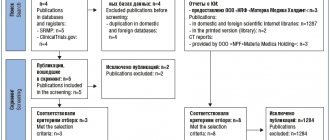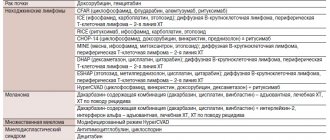Endometriosis is an immune-dependent, dyshormonal and genetically determined disease, which is characterized by benign proliferation of endometrial tissue. Endometriosis is characterized by a long and progressive course. A woman can learn about this pathology during an examination at a gynecologist or during an ultrasound diagnosis of the pelvic organs. After conducting diagnostic examinations, the doctor selects appropriate treatment with hormonal drugs or through surgery.
Endometriosis is an insidious disease, since its symptoms appear in the later stages of development of the pathology, when the lesions have reached large sizes or have degenerated into cysts. Therefore, if the menstrual cycle is disrupted, its duration is shortened, or painful sensations appear in the lower abdomen during sexual intercourse, during menstruation, or during bowel movements, you should immediately consult a doctor. It is also necessary to visit a gynecologist if you experience bleeding of unknown etiology that appears regardless of the menstrual cycle.
The reasons that can contribute to the development of endometriosis are hormonal imbalances, weakened immunity, inflammatory processes in the organs of the reproductive system and the whole body, as well as mechanical damage to the endometrium due to abortions, miscarriages, adhesions, and curettage. The condition of the genital organs is also negatively affected by poor environmental conditions, poor diet, smoking, alcohol abuse, stress and constant emotional tension.
Relevance
Endometriosis is
a pathological process in which benign growth of tissue occurs outside the uterine cavity, similar in morphological and functional properties to the endometrium [1]. Despite the existence of many controversies regarding the mechanisms responsible for its pathogenesis and progression, it is widely known that endometriosis is an estrogen-dependent chronic inflammatory disease [2], and genetic and epigenetic mechanisms are also considered [3].
The problem of treating endometriosis (both internal and external) remains unresolved to this day. The main goals of treatment for this disease are: removal of the focus of endometriosis; reduction in pain intensity; infertility treatment; prevention of progression; prevention of relapses, which reduces the need for radical surgery and allows preserving a woman’s reproductive function [1].
The variety of clinical manifestations and variability of responses to hormonal therapy require an individual approach to each specific case. According to the practice committee of the American Society for Reproductive Medicine, “endometriosis should be considered a chronic disease that requires a lifelong treatment plan to maximize the use of medical options and prevent repeated surgical procedures” [4].
Deep infiltrative endometriosis is a form of endometriosis in which pathological tissue can penetrate up to 5 mm below the surface of the affected structure [5]. The frequency of deep infiltrative forms is 20% of all cases of the disease, with the uterosacral ligaments being the most common location [6]. Two pathogenetic mechanisms explain the pain associated with deep infiltrative endometriosis: chronic inflammation associated with the metabolic activity of the ectopic epithelium, and secondary fibrosis caused by the invasion of endometriotic glands into scar tissue [7]. Treatment of deep infiltrative endometriosis can be either surgical, aimed at restoring normal anatomy by removing endometriotic lesions, or conservative (hormonal). Deeply infiltrating endometriosis causes the most severe pain, with potentially serious clinical consequences and the greatest risk if surgery is performed. Patients with this pathology should be considered a high-risk group, and progestins should be prescribed as first-line therapy [8]. Numerous published studies indicate that the choice of tactics aimed at surgical treatment of deep infiltrative endometriosis is in many cases considered a difficult task, because the operation can be associated with significant technical difficulties and the risk of serious complications [9]. With deep infiltrative endometriosis, the most complete excision of the lesions is required to reduce symptoms associated with the lesion [10]. However, surgical treatment is not always adequate. Thus, according to some authors, the rate of postoperative recurrence of endometriosis was 30% and 43% 4 and 8 years after surgery, respectively [11]. Therefore, there remains a need for effective, safe and well-tolerated drug therapy that can be used long-term if necessary. To reduce the frequency of recurrence and intensity of pelvic pain, conservative therapy, primarily hormones, is required [7, 12, 13]. However, the problem of targeted selection of a drug for drug therapy continues to be a priority. The principle of “no more than one operation in a patient with endometriosis” or an attempt to avoid surgical treatment altogether force us to choose not only highly effective, but also safe medications. Most international recommendations include combined oral contraceptives (COCs) and progestins as first-line medications. However, COCs do not have officially registered indications for the treatment of endometriosis, as well as clinical evidence of effectiveness [14]. The potential adverse effect of long-term COC use on the progression of endometriosis should be considered. In contrast, there are randomized controlled trials that support the use of progestins, not only for the treatment of pelvic pain associated with endometriosis, but also for suppressing the growth of endometrial ectopia. Therefore, they should be considered as first-line drugs in the treatment of endometriosis [15].
Gonadotropin-releasing hormone (GnRH) agonists cannot be considered as drugs of choice for long-term therapy due to the adverse vasomotor effects and decreased bone mineral density associated with estrogen deficiency [16].
Features of hormonal treatment of endometriosis
Since endometriosis is a hormone-dependent disease, in most cases the doctor selects hormonal medications for the patient. Even if surgery was performed, in order to avoid relapses, a course (at least 6 months) of hormonal therapy is prescribed.
Among the advantages of treating endometriosis with drugs, it is worth highlighting:
- elimination of the activity of pathological pathogenic cells;
- the ability to avoid surgery and possible complications after it;
- restoration and preservation of reproductive function;
- elimination of painful sensations that are accompanying symptoms of endometriosis.
Despite its great popularity, treating endometriosis with hormonal drugs has a number of disadvantages. Thus, long-term use of such drugs has a negative impact on the general condition of the body - the patient may develop dependence on a particular drug. Hormonal therapy is aimed at stopping the development of foci of endometriosis without eliminating the causes of this disease, so after such treatment, endometriosis may develop again over time.
With long-term use of hormonal drugs, or when a woman was prescribed inappropriate pills for the treatment of endometriosis, she may experience:
- swelling;
- nausea and vomiting;
- uterine bleeding;
- sudden weight gain;
- swelling of the mammary glands;
- headaches and dizziness;
- development of chronic diseases of the gastrointestinal tract, kidneys, cardiovascular system;
- tides;
- atrophic vaginitis.
Another disadvantage is the long duration of treatment and the high cost of some drugs.
Treatment of endometriosis with tablets is not prescribed if the patient has:
- allergic reactions to some components;
- liver diseases;
- ulcerative gastritis;
- diseases of the cardiovascular system;
- increased blood clotting;
- diabetes mellitus, pituitary insufficiency;
- increased thrombus formation;
- previous history of heart attacks or strokes.
Dienogest in the treatment of endometriosis
Progestins are considered as an alternative option for inhibiting estrogen-induced lesion proliferation and reducing pain associated with endometriosis [17]. By inducing amenorrhea and stopping menstrual bleeding (and reflux), or even simply reducing its severity, they lead to a decrease in the entry of red blood cells into the abdominal cavity. This leads to a reduction in oxidative stress, which is the main source of inflammation caused by excess free iron and heme in the pelvis [18]. Dienogest is the only progestogen that has been developed specifically for the treatment of endometriosis. Among oral progestins, dienogest is unique in that it is being systematically investigated for the treatment of endometriosis in comprehensive preclinical and clinical research programs [19–22]. Dienogest was registered in the Russian Federation in 2011.
Dienogest (for example, the drug Visanne
) is a 4th generation progestogen and combines the pharmacological properties of the progesterone group and progesterone-like compounds, as well as 19-nortestosterone derivatives [21]. Dienogest is the first gestagen that provides a clinically significant antiandrogenic effect without exhibiting estrogenic and androgenic activity [23]. Studies have shown that dienogest has an anovulatory and antiproliferative effect by suppressing the secretion of cytokines in the stroma of endometrial cells. Progestins inhibit the growth of endometriotic tissue, causing decidualization followed by atrophy of endometriotic implants [4]. Additional mechanisms of action include inhibition of matrix metalloproteinase-mediated growth and implantation of ectopic endometrium [24] and inhibition of angiogenesis [25]. On the other hand, dienogest can improve sensitivity to progesterone in endometriotic tissue by increasing the ratio of progesterone receptor isoforms B/A [26]. The precise mechanisms behind the decreased progesterone response in patients with endometriosis remain unclear. It is possible that the impaired action of progesterone in the endometrium of patients with endometriosis may be associated with the innate resistance of the endometrium itself to progesterone, and not with a violation of progesterone secretion. The pharmacological mechanisms of action of dienogest may include antiovulatory activity leading to a decrease in serum estradiol levels, and direct antiproliferative and anti-inflammatory effects on endometrial cells. Dienogest significantly reduces estrogen levels in endometriotic tissue by inhibiting aromatase and 17β-hydroxysteroid dehydrogenase type 1 in stromal cells of ovarian endometriomas, increases apoptosis of endometriotic cells and reduces the production of proinflammatory cytokines by endometriotic stromal cells [27]. In addition, it reduces the production and release of estradiol-induced angiogenic factors such as vascular endothelial growth factor, which confirms the observed suppression of angiogenesis previously shown in a mouse model [28]. In addition, dienogest is able to stimulate apoptosis in endometrioid cells [29].
Analysis of long-term use of dienogest
The above requires analyzing the long-term use of dienogest for the treatment of endometriosis. A double-blind, placebo-controlled study showed that treatment with dienogest for 12 weeks. was more effective than placebo treatment in reducing pain associated with endometriosis. Approximately similar results were obtained when analyzing the use of dienogest at a dose of 2 mg/day for 24 weeks. [thirty]. Follow-up of patients up to 53 weeks. also showed a sustained reduction in pelvic pain with minimal side effects [31]. According to the instructions for medical use of the drug Visanne, the most common side effects include: vaginal bleeding, headache, discomfort in the mammary glands, decreased mood and acne [32]. Pooled analysis of four randomized European studies with treatment periods of dienogest 2 mg/day up to 65 weeks. showed that side effects associated with taking dienogest 2 mg were relatively rare and well tolerated by patients [33]. It is believed that the frequency of bleeding depends on the initial level of estrogen, which, in turn, depends on body weight. Thus, a study by T. Strowitzki et al. showed that the mean serum estradiol level in European women taking dienogest was approximately 66.7 pg/ml with an average body weight of 62.4 kg [34], while in Japan it was 38 pg/ml with an average body weight of 52 .1 kg [35].
The current pooled analysis shows that the mean change in body weight with continued treatment with dienogest up to 62 weeks. is small and does not differ significantly from that observed in the placebo group [33].
An important advantage of dienogest is that it does not reduce bone mineral density and does not cause side effects associated with hypoestrogenism, and therefore can be prescribed for a longer period [30]. The level of estradiol during treatment with dienogest at a dose of 2 mg/day progressively decreased and amounted to 36±13 pg/ml after 36 months. and 28±12 pg/ml after 60 months. treatment [34]. Thus, estradiol levels are maintained within the “therapeutic window” proposed by the Barbieri threshold theory of 30–50 pg/ml [36], at which estrogen suppression is sufficient to inhibit the growth of endometriotic lesions, but moderate enough to prevent hypoestrogenic side effects [37]. This is especially important for treating adolescent girls and young women because they have not yet reached maximum bone density.
For example, when GnRH agonists are used to treat endometriosis, the only option currently available to restore estradiol levels sufficient to avoid menopausal symptoms and loss of bone mineral density is the combined use of a GnRH agonist and estrogens/progestins (add-back therapy). However, additional administration of estrogens can lead to disease progression and increase the cost of treatment.
Long-term therapy with dienogest at a dose of 2 mg/day also showed a significant reduction in pain after 24–52 weeks. with acceptable side effects [21]. Compared to progestins with androgenic activity, such as medroxyprogesterone acetate and norethindrone acetate, dienogest has a more favorable safety profile with low drops in androgenic effects. Dienogest at a dose of 2 mg/day has been shown to be more effective than dydrogesterone at a dose of 10 mg twice a day for the relief of endometriosis-associated pain, with a corresponding safety profile. This finding is significant because pelvic pain is one of the most important symptoms of endometriosis [38]. Early studies showed that there is no convincing evidence to support the therapeutic use of dydrogesterone in endometriosis [39]. In addition, national clinical guidelines for the treatment of endometriosis state that the use of progestogens in a cyclic regimen (dydrogesterone 40–60 mg for 6–18 months) is ineffective compared with placebo [40].
Byzanne
Use during pregnancy and breastfeeding
Data on the use of Visanne in pregnant women are limited.
Data obtained from animal studies and data on the use of dienogest in women during pregnancy have not identified a specific risk for pregnancy, fetal development, labor and development of the child after birth. The drug Visanne should not be prescribed to pregnant women due to the lack of need for treatment of endometriosis during pregnancy. Taking Visanne during breastfeeding is not recommended, because Animal studies indicate that dienogest is excreted in breast milk.
The decision to stop breastfeeding or to refuse to take Visanne is made based on an assessment of the ratio of the benefits of breastfeeding for the child and the benefits of treatment for the woman.
Use for liver dysfunction
Contraindicated: severe liver disease currently or in history (in the absence of normalization of liver function tests); liver tumors (benign and malignant) currently or in history. In rare cases, benign and, even less frequently, malignant liver tumors have been reported during the use of hormonal substances similar to those contained in Visanne. In some cases, these tumors have resulted in life-threatening intra-abdominal bleeding. If a woman taking Visanne has severe pain in the upper abdomen, an enlarged liver, or signs of intra-abdominal bleeding, then the differential diagnosis should take into account the possibility of a liver tumor.
Use for renal impairment
There are no data indicating the need for dose adjustment in patients with kidney disease.
Use in children
Contraindicated in children and adolescents under 18 years of age (the effectiveness and safety of use in adolescents has not been established).
Use in elderly patients
Not used in postmenopausal women.
special instructions
Before starting to take Visanne, pregnancy must be ruled out. While taking Visanne, if contraception is necessary, patients are advised to use non-hormonal contraceptive methods (for example, barrier).
Fertility
According to available data, while taking Visanne, most patients experience suppression of ovulation. However, Visanne is not a contraceptive.
According to available data, the physiological menstrual cycle is restored within 2 months after stopping Visanne.
The use of Visanne in women with a history of ectopic pregnancy or dysfunction of the fallopian tubes should be decided only after a careful assessment of the ratio of expected benefits and possible risks.
Since Visanne is a progestogen-only drug, it can be assumed that special warnings and precautions for the use of other drugs of this type apply to Visanne, although not all of them were confirmed in clinical studies of Visanne.
If any of the following conditions or risk factors are present or worsened, an individual benefit-risk assessment should be performed before starting or continuing to take Visanne.
Circulatory disorders
In the process of epidemiological studies, insufficient evidence was obtained to confirm the existence of a connection between the use of drugs with only a progestin component and an increased risk of myocardial infarction or cerebral thromboembolism. The risk of cardiovascular events and cerebrovascular accidents is more likely associated with increasing age, arterial hypertension and smoking. The risk of stroke in women with arterial hypertension may increase slightly when taking drugs with only a progestin component.
Epidemiological studies indicate the possibility of a statistically insignificant increase in the risk of venous thromboembolism (deep vein thrombosis, pulmonary embolism) due to the use of drugs with only a progestin component. Well-established risk factors for the development of venous thromboembolism (VTE) include a relevant family history (VTE in a sibling or parent at a relatively early age), age, obesity, prolonged immobilization, major surgery, or major trauma. In case of prolonged immobilization, it is recommended to stop taking Visanne (for planned surgery, at least four weeks before it) and resume use of the drug only two weeks after complete restoration of motor ability.
The increased risk of thromboembolism in the postpartum period should be taken into account.
If arterial or venous thrombosis develops or is suspected, the drug should be stopped immediately.
Tumors
A meta-analysis of 54 epidemiological studies revealed a small increase in the relative risk (RR = 1.24) of developing breast cancer in women who used oral contraceptives (OCs), predominantly estrogen-progestin drugs, at the time of the study. This increased risk gradually disappears over 10 years after stopping use of combined oral contraceptives. Because breast cancer is rare in women under 40 years of age, the slight increase in breast cancer diagnoses in women who are currently taking combined oral contraceptives or have previously used combined oral contraceptives is small relative to the overall risk of breast cancer. The risk of breast cancer detection in women using progestin-only hormonal contraceptives is probably similar in magnitude to the corresponding risk associated with the use of combined oral contraceptives. However, the evidence for progestin-only products is based on much smaller populations of women using them and is therefore less convincing than the evidence for combined oral contraceptives. It is not possible to establish a cause-and-effect relationship based on these studies. The observed pattern of increased risk may be due to earlier diagnosis of breast cancer in women taking OCs, the biological effects of OCs, or a combination of both factors. Malignant breast tumors that are diagnosed in women who have ever used OCs are usually clinically less severe than in women who have never used hormonal contraception.
In rare cases, benign and, even less frequently, malignant liver tumors have been reported during the use of hormonal substances similar to the one contained in Visanne. In some cases, these tumors have resulted in life-threatening intra-abdominal bleeding. If a woman taking Visanne has severe pain in the upper abdomen, an enlarged liver, or signs of intra-abdominal bleeding, then the differential diagnosis should take into account the possibility of a liver tumor.
Change in bleeding pattern
For most women, taking Visanne affects the nature of menstrual bleeding.
During the use of the drug Visanne, uterine bleeding may increase, for example, in women with adenomyosis or uterine leiomyoma. Heavy and prolonged bleeding can lead to anemia (in some cases severe). In such cases, discontinuation of Visanne should be considered.
Other states
Patients with a history of depression require careful monitoring. If depression recurs in a serious form, the drug should be discontinued.
Overall, Visanne does not appear to affect blood pressure in women with normal blood pressure. However, if persistent clinically significant arterial hypertension occurs while taking Visanne, it is recommended to discontinue the drug and prescribe antihypertensive treatment.
In case of relapse of cholestatic jaundice and/or cholestatic itching, which first appeared during pregnancy or previous use of sex steroids, Visanne should be discontinued.
Visanne may have minor effects on peripheral insulin resistance and glucose tolerance. Women with diabetes mellitus, especially those with a history of diabetes mellitus during pregnancy, require careful monitoring while taking Visanne.
In some cases, chloasma may occur, especially in women with a history of chloasma during pregnancy. Women prone to developing chloasma should avoid exposure to the sun or ultraviolet radiation while taking Visanne.
Persistent ovarian follicles (often called functional ovarian cysts) may occur while taking Visanne. Most of these follicles are asymptomatic, although some may be accompanied by pelvic pain.
Lactose
1 tablet of Visanne contains 63 mg of lactose monohydrate. Patients on a lactose-free diet with rare hereditary disorders such as galactose intolerance, lapp lactase deficiency or glucose-galactose malabsorption should take into account the amount of lactose contained in Visanne.
Postmenopausal women
Not used in this category of patients.
Patients with renal failure
There are no data indicating the need for dose adjustment in patients with kidney disease.
Medical examination
Before starting or resuming taking Visanne, you should review the patient's medical history in detail and conduct a physical and gynecological examination. The frequency and nature of such examinations should be based on existing standards of medical practice with the necessary consideration of the individual characteristics of each patient (but at least once every 3-6 months) and should include blood pressure measurement, assessment of the condition of the mammary glands, abdominal cavity and pelvic organs, including cytological examination of the cervical epithelium.
Use in pediatrics
Visanne is contraindicated in children and adolescents under 18 years of age (the effectiveness and safety of use in adolescents has not been established).
Impact on the ability to drive vehicles and operate machinery
As a rule, Visanne does not affect the ability to drive a car or operate machinery, however, patients who have difficulty concentrating should be careful.






